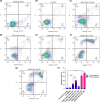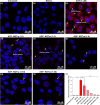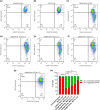Self-Assembly of Accumulated Sphingolipids into Cytotoxic Fibrils in Globoid Cell Leukodystrophy and Their Inhibition by Small Molecules In Vitro
- PMID: 40603002
- PMCID: PMC12269364
- DOI: 10.1021/acsnano.5c05498
Self-Assembly of Accumulated Sphingolipids into Cytotoxic Fibrils in Globoid Cell Leukodystrophy and Their Inhibition by Small Molecules In Vitro
Erratum in
-
Correction to "Self-Assembly of Accumulated Sphingolipids into Cytotoxic Fibrils in Globoid Cell Leukodystrophy and Their Inhibition by Small Molecules in Vitro".ACS Nano. 2025 Sep 10. doi: 10.1021/acsnano.5c14040. Online ahead of print. ACS Nano. 2025. PMID: 40930988 No abstract available.
Abstract
Globoid cell leukodystrophy (GLD) is a rare hereditary inborn error of metabolism due to recessive mutations that cause loss of function of the enzyme galactosylceramidase (GALC). This results in the accumulation of the sphingolipids galactosylceramide (GalCer) and galactosylsphingosine (GalSph) in the lysosomes of neuronal cells. The accumulated GalCer and GalSph in cerebral macrophages of GLD patients are neurotoxic to oligodendrocytes and Schwann cells, leading to demyelination in the nervous system. The disease typically presents with infantile onset in the first six months of life and death by age 2. Here, we identified a supramolecular structure of GalCer and GalSph that may contribute to GLD pathology. Using biophysical assays commonly used for studying proteinaceous amyloids, e.g., amyloid-specific dyes, microscopical imaging, and a series of analytical methods (FTIR, PXRD, and SAXS), we demonstrate that both GalCer and GalSph can self-assemble in vitro into highly organized fibrils reminiscent of fibrils of amyloidogenic proteins. These fibrils exhibit significant cytotoxicity to both neuronal and oligodendroglial cells. Using an inhibitor of the GALC enzyme in cell culture to mimic the GLD pathophysiology, we could detect the accumulation of these fibrils in cells. We also observed that small molecules, which are bona fide inhibitors of proteinaceous amyloids, effectively mitigated the formation of the GalCer and GalSph fibrillar structures in vitro. Finally, the small molecule ameliorated the cytotoxic effects of the sphingolipid fibrils in SH-SY5Y cells, suggesting a potential avenue for therapeutic intervention in GLD orphan disease.
Keywords: apoptosis; galactosylceramide; galactosylsphingosine; globoid cell leukodystrophy; self-assembly; small molecule inhibitors; sphingolipids.
Figures
















Similar articles
-
Perinatal loss of galactosylceramidase in both oligodendrocytes and microglia is crucial for the pathogenesis of Krabbe disease in mice.Mol Ther. 2024 Jul 3;32(7):2207-2222. doi: 10.1016/j.ymthe.2024.05.019. Epub 2024 May 11. Mol Ther. 2024. PMID: 38734898 Free PMC article.
-
Quantification profiles of enzyme activity, secretion, and psychosine levels of Krabbe disease galactosylceramidase missense variants.J Biol Chem. 2025 Jul;301(7):110315. doi: 10.1016/j.jbc.2025.110315. Epub 2025 May 29. J Biol Chem. 2025. PMID: 40449593 Free PMC article.
-
Galactosylceramide and galactosylsphingosine loading studies in cultured skin fibroblasts in human and murine globoid cell leukodystrophy.Biochem Biophys Res Commun. 1990 Jan 30;166(2):1053-60. doi: 10.1016/0006-291x(90)90917-c. Biochem Biophys Res Commun. 1990. PMID: 2302222
-
Krabbe Disease.2000 Jun 19 [updated 2018 Oct 11]. In: Adam MP, Feldman J, Mirzaa GM, Pagon RA, Wallace SE, Amemiya A, editors. GeneReviews® [Internet]. Seattle (WA): University of Washington, Seattle; 1993–2025. 2000 Jun 19 [updated 2018 Oct 11]. In: Adam MP, Feldman J, Mirzaa GM, Pagon RA, Wallace SE, Amemiya A, editors. GeneReviews® [Internet]. Seattle (WA): University of Washington, Seattle; 1993–2025. PMID: 20301416 Free Books & Documents. Review.
-
Management of urinary stones by experts in stone disease (ESD 2025).Arch Ital Urol Androl. 2025 Jun 30;97(2):14085. doi: 10.4081/aiua.2025.14085. Epub 2025 Jun 30. Arch Ital Urol Androl. 2025. PMID: 40583613 Review.

